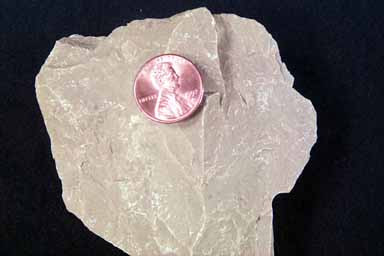|
LIMESTONE #2 Micrite Limestone Go on to: #1 | #2 | #3 | #4  Detail of this specimen
Detail of this specimen>>> Return to previous
Return to: Alphabetical Listing Basic Key Carbonate Key |
||
|
Composition
Micrite = lime mud; CaCO3, the mineral calcite. Micrite is the equivalent of clay (rock = shale) in clastics. Originally deposited as microscopic aragonite needles, but now converted to calcite and then calcite cemented to form the rock. See Origin of Micrite for more details.
|
Description
Dense, uniform, fine grained rock with conchoidal fracture. This micrite has no discernable structure to it at all, and thus shows the nature of the pure rock. One note, relatively pure micrites are light gray or tan (as this specimen), but it is not uncommon for micrites to be contaminated. Which leads to the cardinal rule about sedimentary rocks - " Never trust color" when it comes to identifying sedimentary rocks. It will get you into trouble more times than not.
|
|
|
Tectonic Association
Carbonates of all types are commonly associated with regions of tectonic stability and tropical climates, that is no mountain building, and stable, shallow water environments associated with continental shelves or epeiric (epicontinental) seas.Go to Carbonate Tectonics for more explanation. |
Formation & Environments
Micrite is one of the most common carbonate rocks. Most of what people call " limestone" is largely or exclusively micrite. As with clay (shale) it is deposited in generally quiet water, and appears in any environment where those conditions exist. This specimen could have come from a tidal lake, or a subtidal lagoon, or some similar environment. |
|